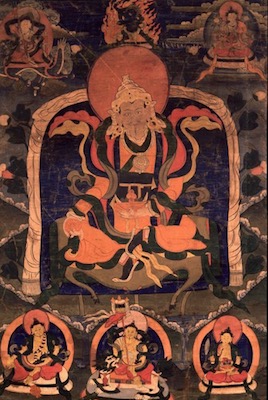King Tri Ralpachen: Difference between revisions
No edit summary |
mNo edit summary |
||
| Line 1: | Line 1: | ||
[[image:King-Tri-Ralpachen-1.jpg|frame||'''King Tri Ralpachen''']] | [[image:King-Tri-Ralpachen-1.jpg|frame||'''King Tri Ralpachen''']] | ||
'''King Tri Ralpachen''' (Tib. ཁྲི་རལ་པ་ཅན་, [[Wyl.]] ''khri ral pa can'') (9th century, 806–838<ref>As given by Derek F. Maher | '''King Tri Ralpachen''' (Tib. ཁྲི་རལ་པ་ཅན་, [[Wyl.]] ''khri ral pa can'') (9th century, 806–838<ref>As given by Derek F. Maher in his translation of Shakabpa's political history</ref>) — one of the [[three ancestral religious kings]] and one of King [[Trisong Detsen]]'s grandsons.<Ref>It is said that he did not like to cut his hair and so he was called Ralpachen which means 'the one with locks of hair'.</ref> He ruled Tibet from 815 until 838, when he was assassinated. Trisong Detsen had three sons—the oldest was [[Mune Tsepo]], the middle one [[Murub Tsenpo|Murup Tsepo]], and the youngest [[Mutik Tsepo]]. All three spread the Buddhist teachings in Tibet. Tri Ralpachen was one of the five sons of Mutik Tsepo and was said to be an emanation of [[Vajrapani]]. He was extremely devoted to the teachings of the [[Buddha]] and is famous for having built one thousand temples. | ||
He invited many scholars from India, like Surendrabodhi, Shilendrabodhi, Danashila. And to them and the learned masters from Tibet such as Ratnarakshita and Dharmadashila, as well as the [[lotsawa]]s Jñanasena and so on, he said: | He invited many scholars from India, like Surendrabodhi, Shilendrabodhi, Danashila. And to them and the learned masters from Tibet such as Ratnarakshita and Dharmadashila, as well as the [[lotsawa]]s Jñanasena and so on, he said: | ||
Revision as of 06:17, 6 April 2018

King Tri Ralpachen (Tib. ཁྲི་རལ་པ་ཅན་, Wyl. khri ral pa can) (9th century, 806–838[1]) — one of the three ancestral religious kings and one of King Trisong Detsen's grandsons.[2] He ruled Tibet from 815 until 838, when he was assassinated. Trisong Detsen had three sons—the oldest was Mune Tsepo, the middle one Murup Tsepo, and the youngest Mutik Tsepo. All three spread the Buddhist teachings in Tibet. Tri Ralpachen was one of the five sons of Mutik Tsepo and was said to be an emanation of Vajrapani. He was extremely devoted to the teachings of the Buddha and is famous for having built one thousand temples.
He invited many scholars from India, like Surendrabodhi, Shilendrabodhi, Danashila. And to them and the learned masters from Tibet such as Ratnarakshita and Dharmadashila, as well as the lotsawas Jñanasena and so on, he said:
“When the teachings were translated at the time of my forefathers, the scholars used many terms unknown to the Tibetan language. Change those which contradict the teachings or the rules of grammar, and those which are difficult to understand preferably by using familiar terms of colloquial Tibetan. Revise in this way the translations of the Mahayana and Hinayana texts.”
Accordingly they revised the translations, such as those of the Prajñaparamita. Yet since the meaning of the inner tantras cannot be grasped by ordinary persons they did not revise them.
Notes
References
Based on the History of the Dharma by Dudjom Rinpoche (Wyl. bdud 'joms chos 'jung).